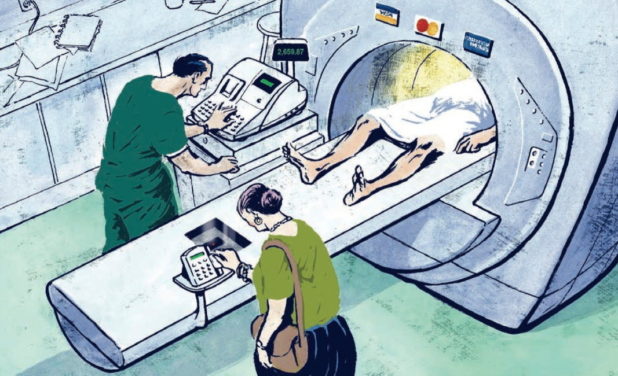Pomidor Quixote
Daily Stormer
August 17, 2019
The Atlantic has published a piece talking about the case of an Egyptian doctor purposefully misdiagnosing people with epilepsy to enrich himself while working in Michigan, and how such occurrences are not as uncommon as people would think.
The headaches started when Mariah Martinez was 10 years old. It was 2003, and she was living in Dearborn, Michigan, with her mother and two sisters. Whenever a headache struck, she would want to put her head down, stay in the dark, and be alone.
Martinez saw her primary-care physician, who referred her to Yasser Awaad, a pediatric neurologist at a hospital that was then known as Oakwood Healthcare. Right away, Martinez told me, Awaad ordered an electroencephalogram, or EEG, a test that uses electrodes to detect abnormal electrical activity in the brain. In a small room, Martinez was wrapped in bandages and had wires placed all over her head. The procedure required her to be sleep-deprived; she came in on one or two hours of sleep after staying up much of the night watching TV.
After performing two EEGs a week apart, Awaad, according to court documents, told Martinez’s mother that her daughter had what are called atypical partial absence seizures. Rather than full-body convulsions, absence seizures are those in which a person stares off into space, blinks, or makes small, repetitive motions. Martinez was confused by the diagnosis; she didn’t know what epilepsy was. Awaad, she said, told her that headaches or staring spells could be signs she was having a seizure, or had just had one. So each time she caught herself daydreaming, she thought, Oh my God, I had a seizure!
Awaad put Martinez on the anti-seizure medication Lamictal. Several months later, her headaches had gotten even worse, and Awaad increased her dose, court documents say. Over the next four years, Martinez underwent 10 more EEGs under the care of Awaad. He told her that most of them were abnormal. Eventually, Martinez was taking a high dose of 400 milligrams of Lamictal daily. The medication made her tired and withdrawn, to the point where she didn’t feel like herself. But she continued taking it, thinking it was good for her health.
Four years after she first saw Awaad, Martinez went to see another doctor, Brian Woodruff, because Awaad had left his practice. Woodruff performed his own EEG, and the result was so surprising, Martinez’s mother didn’t believe it at first. It was completely normal. “I have come to the determination she never had seizures,” Woodruff would later testify in court. What’s more, he said, “You don’t get headaches like this with absence epilepsy.” In fact, Lamictal can cause headaches.
More than a decade later, Martinez is one of hundreds of patients who have accused Awaad of intentionally misreading their EEGs and misdiagnosing them with epilepsy in childhood, all to increase his pay. In June, Martinez’s case became the first to go to trial in Michigan. The case shines a light on the grim world of health-care fraud—specifically, the growing number of doctors who are accused of performing unnecessary procedures, sometimes for their own personal gain.
At Awaad’s trial, Martinez’s lawyers painted a portrait of a man on a quest to conduct as many EEGs as possible, and of a hospital that looked the other way as red flags flew up around him. The lawyers accused Awaad of being hired by Oakwood Healthcare on a contract that compensated him for each EEG he performed. In his time at the hospital, from 1999 to 2007, his salary rose from $185,000 to $300,000, and he qualified for bonuses up to $220,000 if he met certain billing targets. Brian McKeen, Martinez’s lawyer, told jurors that Awaad had “turned that EEG machine into an ATM.”
In court, Awaad denied Martinez’s accusations. He claimed that there were “many reasons” to do an EEG, such as to confirm a diagnosis or to see if a medication was working. Awaad was born in Egypt, and after stints at New York University and the Children’s Hospital of Michigan, he told the court, he went to Oakwood to serve the area’s many Arabic-speaking patients. (Awaad and his lawyer did not return requests for comment.)
…
Cases like Awaad’s are especially fraught because differing diagnoses of the same patient are common in health care; it’s where the term second opinion comes from. Often, the only way a misdiagnosis is discovered is if a patient has another specialist check a doctor’s work. Even then, it’s not always clear whether a wrong diagnosis was intentional or not. As Louis Saccoccio, the head of the National Health Care Anti-Fraud Association, put it to me, “People rely so much on physicians’ professionalism that when that trust is violated, it’s a tough thing to catch.”
…
Saccoccio told me that while it’s hard to determine how common the intentional-misdiagnosis style of fraud is, the more typical variety is called “upcoding”: doing a cheaper procedure but billing for a more expensive one. (Awaad is accused of doing this, as well.) U.S. government audits suggest that about 10 percent of all Medicare claims are not accurate, though Malcolm Sparrow, a Harvard professor of public management, told me that’s likely an underestimate. He added that it’s not possible to know how many of these inaccuracies are false diagnoses, rather than other kinds of errors.
Sparrow speculated that doctors cheat the system because “they believe they won’t get caught, and mostly they don’t get caught.” There’s also the fact that doctors often do know more than their patients about various diseases. Sometimes, fraudulent doctors lord that knowledge over patients who get suspicious. In 2015, Farid Fata was sentenced to 45 years in prison for administering unnecessary chemotherapy to 553 patients. “Several times when I had researched and questioned his treatment, he asked if I had fellowshipped at Sloan Kettering like he had,” one of his patients, Michelle Mannarino, told Healthcare Finance.
Some lawyers argue that many of the doctors who get swept up in these kinds of cases are doing honest work: These doctors simply have a different opinion than another doctor who is later asked to review their diagnoses. Writing in The Wall Street Journal last year, the lawyers Kyle Clark and Andrew George pointed out that a decade ago, most health-care fraud centered on something the doctor failed to do, such as neglecting to treat a patient who was actually sick. Now prosecutors are bringing more and more so-called medical-necessity cases, which focus on a test or procedure doctors did do that they shouldn’t have. “Doctors can, and do, honestly disagree by wide margins,” Clark and George wrote. “Show two doctors the same image, and you may get wildly varying—yet highly confident—opinions of what it shows.”
The whole thing is a mess.
How can we discern the honest “second opinion” kind of differences in diagnoses from the malicious ones intended to enrich the doctor?
Under the current sickness care system, that’s a tough question to answer because like most things in our society nowadays, it’s upside down. The incentives are in the wrong places. The kind of fraud described in this story wouldn’t happen if doctors didn’t have a strong financial incentive to do it.
If we wanted doctors to make people healthy and to keep people healthy, the system should be set up in a way that rewards doctors with healthy patients instead of rewarding doctors “treating” lots of unhealthy ones.
We can fix this problem if we change the way we look at the “health” care system.
If doctors got paid according to how healthy their patients were, we’d have healthier people. How about paying more to doctors whose patients overcome sicknesses without spending a fortune? How about paying bonuses to doctors whose patients don’t get sick very often? Why not provide incentives to spread a healthy lifestyle?
It’s just common sense, but the system is not really set up to protect the health of the population but to squeeze the pockets of the population.
The focus and rewards should be switched to preventive medicine. Doctors should be talking about diet, exercise, sleep patterns, posture, hormonal balance, the importance of moving our bodies, and all the things that strengthen our immune system and help the body do its job and function properly.
Their success should be measured by the number of people they keep healthy, not by the number of people they get on drugs.
This focus on pills that we have now is not just unnecessarily draining in a financial sense — it’s also sucking the life out of people.
 Daily Stormer The Most Censored Publication in History
Daily Stormer The Most Censored Publication in History





